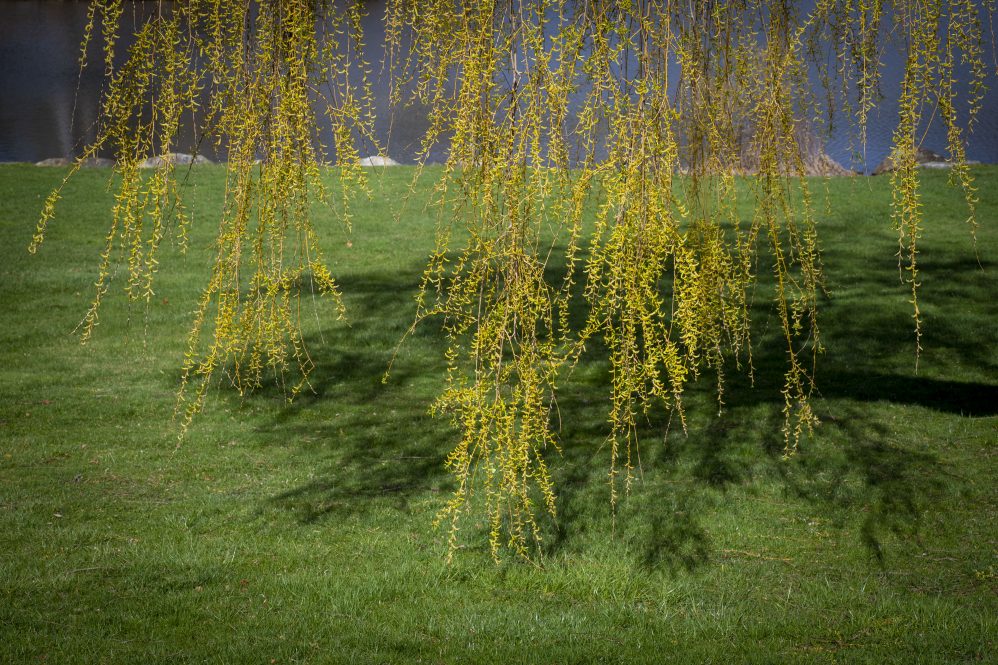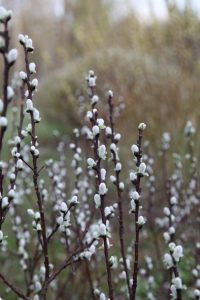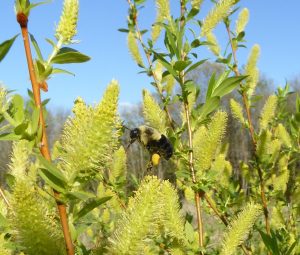Multifaceted species appears everyone from CT to the Arctic, and has a wide variety of uses, from erosion control to pollination

A willow tree overlooking Mirror Lake. (Sean Flynn/UConn Photo)
UConn Department of Plant Science and Landscape Architecture Professor Julia Kuzovkina has researched willows for more than 20 years and is working to bring this important, and often overlooked, species into focus due to its potential to help address many pressing ecological and sustainability challenges we face today. Kuzovkina met with UConn Today to discuss her research on this remarkable species' many benefits.
Can you talk about some of the unique and important qualities of willows?
Though not too many people are familiar with willows, they are an extremely large group of plants that includes about 500 species, and native willows grow everywhere, from Arctic zones to sub-tropical regions on all continents except Australia. The willows that most people are familiar with are weeping willows, which grow frequently in this region, but the range of sizes the willows is amazing, from about two inches tall for a type of willow that grows as a ground cover in Arctic zones to large trees that grow to around 60 to 70 feet tall.

I study different aspects of willow taxonomy, cultivation, and their various uses and I think the history of willows is amazing. Humans have a long history of using willows in different ways. Willow-produced objects like baskets have been made for many centuries but were replaced by plastic containers at the beginning of the 20th century. For centuries extracts from willow bark and leaves were used as a pain reliever until the production of synthetic aspirin, and willows were the chemical precursor for the synthetic production of aspirin. Today willows continue to play new roles with humans.
What roles do willows play in ecosystems?
Willows are very fast-growing, and this is important in various ecological applications. We have been investigating willows for biomass, for biofuel production and phytoremediation in North America and some European countries. Also, willows are important in the ecological recovery of disturbed regions. Willows are also important plants for pollinators. Pollinators are threatened around the world and since willows are among the earliest plants to provide flowers in spring, they are some of the earliest sources of food for pollinators.
Now we are working towards selecting and trying to introduce willows to various applications, such as integrating willows into different cropping systems as part of agroforestry, planting them around farms, incorporating them into riparian buffers along waterways, and building windbreaks, and snow fences, so they can play multiple roles, while also providing an early source of food for pollinators.
Riparian buffers are very important and historically, farmers have reduced riparian zones around agricultural fields more and more because they wanted to get more land to farm. But we must keep the riparian zones intact and since willows have extremely dense and fibrous root systems, they hold the soil very well. We are facing increasing amounts of stormwater and flooding these days due to climate change, like the historic storms that swept through the state on August 18th, and that emphasizes the importance of the use of willows for many applications like erosion control, which is associated with increasing amounts of stormwater, and controlling stormwater is critical.
Another aspect of my work is related to international activities, and this emphasizes the importance of fast-growing trees for many countries. I've been working with The International Commission on Poplars and Other Fast-Growing Trees Sustaining People and the Environment (IPC), a commission under the umbrella of the Food and Agriculture Organization of the United Nations. This commission was founded in 1947 after the Second World War, to recover devastated European regions, and fast-growing trees like poplars and willows were very important. The importance of the Commission remains today as the urgent need to revive many damaged ecosystems was epitomized by the launch of the United Nations Decade on Ecosystem Restoration from 2021-2030. Willows and other fast-growing trees survive in devastated areas devoid of vegetation because they can tolerate poor soil conditions and start building favorable physical environments for other species.
Can you talk about your research with native versus non-native willow species?
Generally speaking, native species are important for our native pollinators. Usually with plants, native species evolve together with pollinators, so native plants provide the most important early nutrition source for pollinators. We wanted to look at differences between introduced and native willows because introduced willows are very fast-growing species that have been under investigation for many years in the United States where they are grown for biofuel production. We use mostly introduced species from Eurasia, Europe, and Asia. In a recent paper, we compared the values of introduced and native species, so we planted both native and introduced species at the research farm we collected pollinators during two spring seasons and compared the number of pollinators and associated species.

We found no significant differences between the introduced and native willows and that was interesting and surprising. It is important to understand that willows evolved and dispersed around the world a long time ago. Chemically, willows that grow in Eurasia are quite like willows growing in North America, and insects do not detect the difference. Both groups of willows provide useful resources for pollinators, which is beneficial because if we increase plantations of introduced willows for different purposes, we know they will provide similar resources for pollinators as native willows.
My current research is related to the selection of native species and introducing them commercially in New England. We call plants that originally grow in the same area ecotypes and this is the safest and the most scientifically appropriate approach. In the last 10 years, I've been traveling and selecting different native willows and two years ago, we started trials to see if nurseries in the region would be interested in growing these willows. Now we are concluding these results, and we hope that our nurseries will start growing native willow selections which we recommend, because, again, it is very critical to introduce willows for pollinators as their first source of food.
Another interesting fact is that willows are one of the most difficult plants to identify, and there is so much confusion with many nurseries selling willows that they call natives but are not actually native. One of my other objectives is to help nurseries introduce these "real" native willows that we have collected in our region. For example, nurseries are selling American pussy willow, which is one of the earliest to bloom, but under this label sometimes they sell a European willow which is very different and could have invasive potential because they are spread by seeds. It also blooms two weeks later than our Native American willow, and these two weeks are a critical time for pollinators. If we intend to plant and help pollinators, we have to plant our native willow which blooms at an appropriate time when pollinators are emerging, not the introduced willow which blooms two weeks later.






